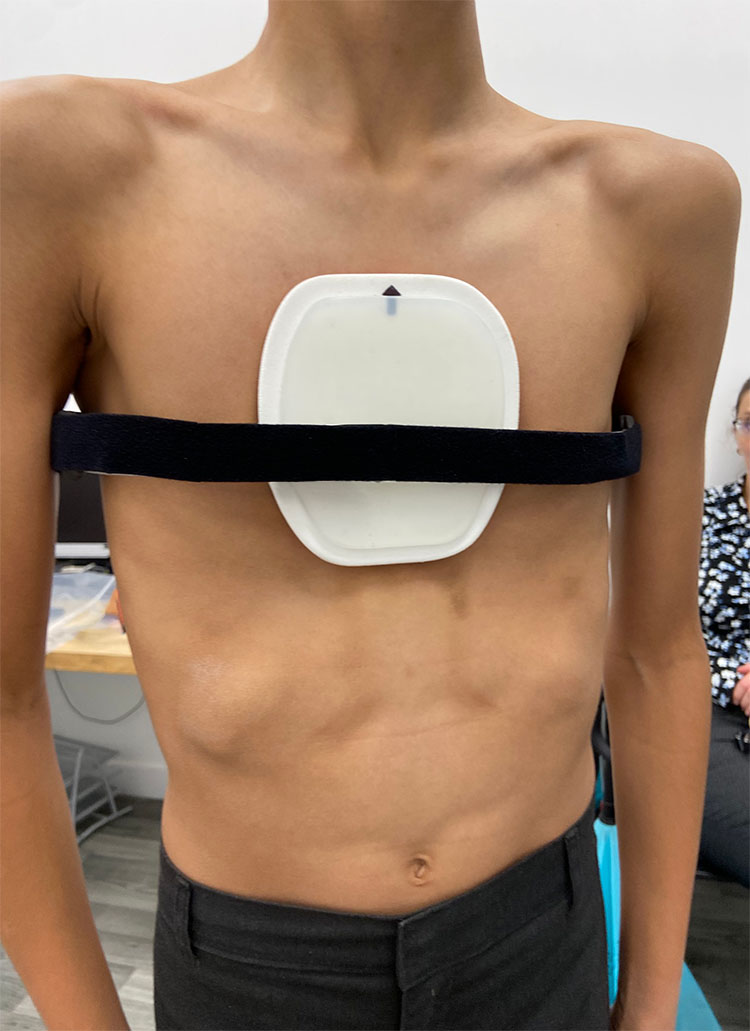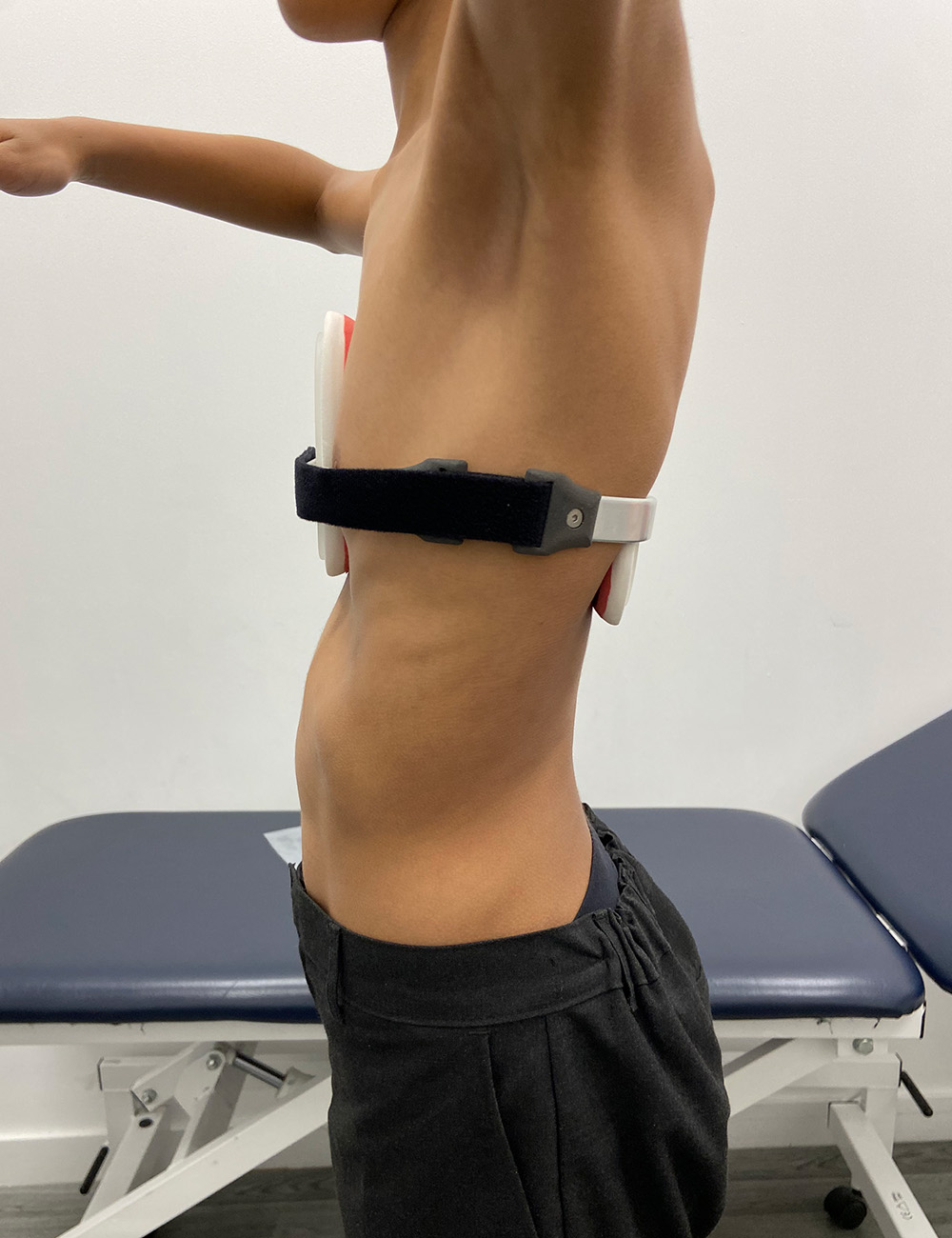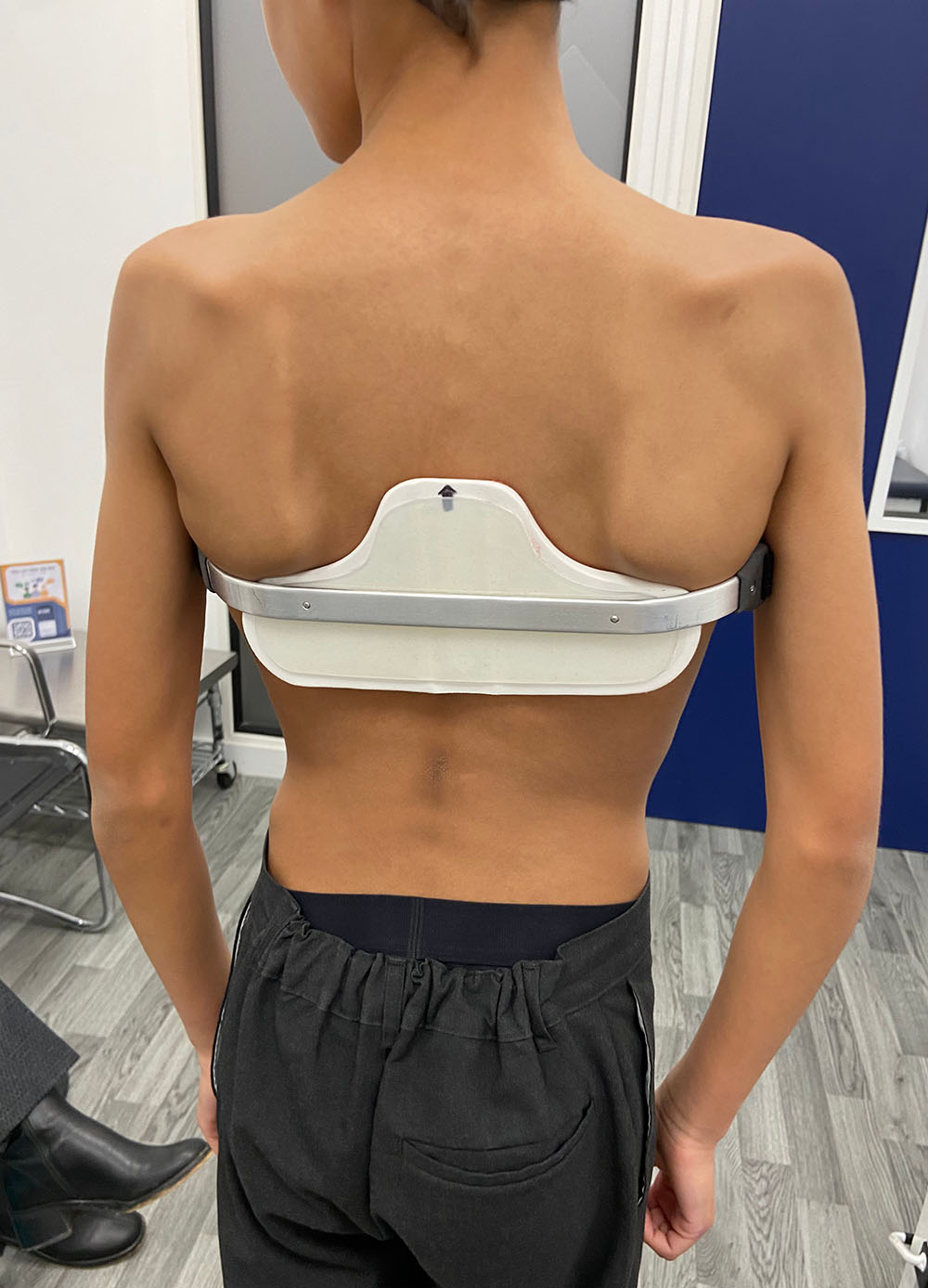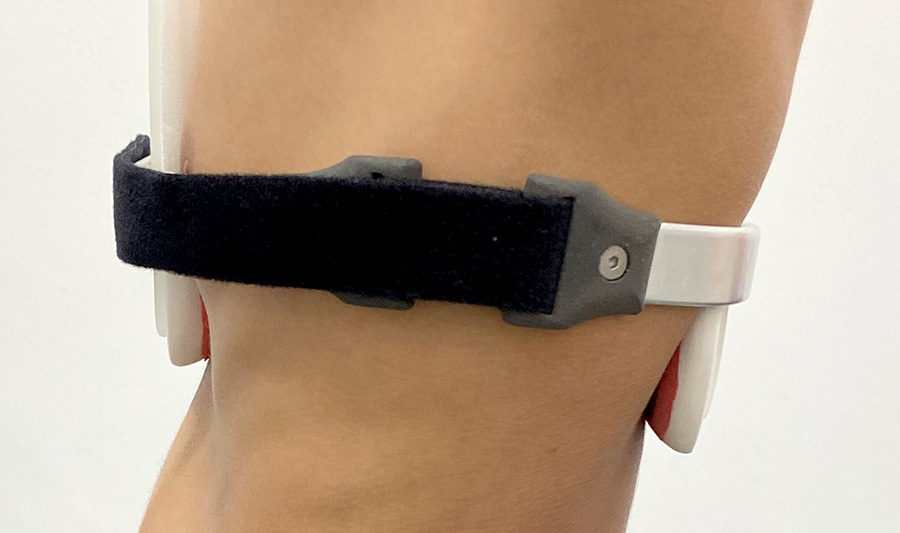
Will wearing his bespoke dynamic chest compressor brace during an appointment
22 January 2024
Maria, Will’s mother, first noticed that there was something wrong with his chest during the summer of 2020. “It was so obvious” she says, “because we could make a direct comparison with his brother, and it did not look anything like his brother’s chest, his chest and ribs were sticking out.”
Due to the Covid pandemic, the UK was still in lockdown, so Maria hit the internet to find out what was causing the problem. She learned about pectus carinatum, a chest wall deformity characterised by an outward protrusion of the sternum and ribs. It's also known as "pigeon chest" because the chest may resemble the shape of a pigeon's breast. It’s quite a common condition affecting 1 in 1,500 people.
“I searched for people who could help treat the condition and found LOC. We were delighted to find that LOC had a clinic in Kingston, as we live nearby”. As it was lockdown, a virtual consultation was arranged and one of LOC’s pectus clinicians confirmed the diagnosis and explained LOC’s non-surgical treatment for the condition.

Side view of Will's bespoke pectus carinatum brace
It was agreed that because of his age (he was 11 years old at the time), it would be best to start treatment when he was a bit older.
Fast forward to 2023 and Will had his braces fitted in April; one for his chest and one for his ribs. Prior to the fitting, Will’s torso was scanned to provide the dimensions for his bespoke braces; the scans also provide an objective measurement of his chest pre-treatment which can be used as the benchmark for judging how well treatment is progressing at later reviews.
Will is under the care of Connor Mumford, one of LOC’s specialist pectus clinicians. Maria adds, “Connor is super helpful and takes a lot of time to make sure that the braces are as comfortable as possible; Will is going through a major growth spurt at the moment so the braces do need adjusting regularly. We never feel rushed at our appointments.”
This depends on several factors; the position of the chest wall deformity, its severity, the flexibility of the chest, the kind of results wanting to be achieved and the age of the person undergoing treatment for pectus excavatum or pectus carinatum.
Early adolescence (roughly between the ages of 12-16 years old) – is an optimum age to start treatment, given that the chest is still maturing, and flexible, permanent correction is more easily achievable. Once bracing treatment is complete and a patient has stopped growing, the deformity will not return. For younger pectus patients, conservative bracing is used to keep a deformity from worsening and can help them to avoid surgery in later life.
For older pectus patients (between the ages of 20 to 30) results can be harder to achieve, as the costal cartilage hardens into the bone as a person matures. Over the years we have successfully treated many adults for both pectus excavatum and pectus carinatum and active adults with flexible chests can expect good results.
Again, this hugely depends on what a patient wants to achieve from treatment; whether that’s avoidance of surgery, improvement in the appearance of the chest shape, reduction in rib flaring etc. All these goals are taken into consideration during your first consultation. While there are no serious health risks of having pectus carinatum or excavatum – beyond the cosmetic – for many patients and parents, treatment outcomes involve improving confidence and self-esteem. During our 2018 Pectus Patient Survey, 92% of pectus carinatum patients surveyed said that treatment had a ‘major improvement’ or ‘an improvement’ on their social life.
You can read the results of our 2018 Pectus Patient Survey and quality of life questionnaire here.
Regular reviews are part of the treatment programme, preferably in clinic with one of our specialist orthotists, or via Skype consultations.
The number of appointments needed will vary from patient to patient but as a general rule, younger pectus patients who are growing at a faster rate will need to be seen more regularly for check-up appointments. This is to ensure that the brace fits well and is guiding the chest into the correct position as growth spurts occur. For other patients, this can be scaled back according to their individual needs and demands.
Regular appointments are beneficial for assessing progress, checking for signs of rubbing and determining whether another brace is needed. Appointments are also good for checking patient compliance to brace wearing and the breathing and exercise programme. At each appointment, we make time for patients to see our physiotherapist to fine-tune their exercise programme and check to see how a patient has been managing with the current programme.
We always advise coming in for appointments whenever you have any concerns about the brace or treatment programme, especially if a brace is rubbing or not fitting correctly. At the London Orthotic Consultancy, we have treated numerous international patients that have benefitted from specially designed braces that leave room to accommodate for growth and that can be adjusted remotely. Follow-up appointments for international patients are conducted via Skype.
This is a very common concern for patients considering treatment; in general, the dynamic chest compressor brace is easy to conceal if you are wearing a loose-fitting shirt for school or work. If you are wearing two chest braces – one for the main deformity and the other for rib flaring – then this may be more noticeable, especially under a t-shirt. Normally loose-fitting clothing will conceal the brace, though it’s likely it will be seen through tight-fitting clothes.
It is really important to continue exercising while going through bracing treatment. Exercise is fundamental to keeping the chest wall flexible. Our treatment programme incorporates a daily exercise routine of around 30-40 minutes of stretching using yoga poses, resistance bands, deep breathing exercises and general muscle stretches. Deep breathing exercises allow the lungs to expand against the chest wall, pushing it outwards.
Exercising with the brace on in the later stages of treatment can also make the chest correction more stable and permanent.
Swimming is one of the best forms of exercise to complement bracing treatment, as the body positions required to swim imitate the resistance band training designed to stretch the chest and increase its flexibility. Some swimming strokes are better for this than others, please check with your clinician. The brace should always be removed for contact sports and for swimming.
For most patients, one brace is often all that is needed to achieve a desired level of correction. They are each designed to last the duration of treatment and accommodate any growth that may occur in that time. Some patients have benefitted from having two braces – one to treat the main deformity and the other to treat rib flaring. For some pectus excavatum patients, having a brace apply pressure to the ribs – in addition to vacuum bell therapy – can greatly reduce the appearance of the depressed sternum area of the chest, forcing it upwards and outwards into a more corrective position.
If you are worried about your chest shape, or your child’s chest shape, then get in touch for a free Skype consultation with one of our pectus specialists who can assess their chest and discuss treatment options. We are always happy to communicate with local GPs, thoracic surgeons and consultants if a patient approaches us for bracing treatment after considering other options.

Will's pectus brace from the back
At one of the reviews in September interim scans were taken of Will’s chest and these showed how much improvement in his chest shape had already been achieved. This is a testament to Will’s compliance with the required wearing regime and the weekly pectus yoga classes with Alva Yoga. Will takes the flexibility classes which are focused on opening the shoulders and chest, building strength there as well as in the legs and back muscles. The objective is to lengthen the spine, increase flexibility and improve mobility, all of which promote a better posture.
Will has also recently begun to wear a new brace with 3D printed clips: “Will really likes it, it’s less clunky than the original one that had metal straps and is more discreet under clothing.”

New 3D-printed clips on the bespoke pectus carinatum brace
For the moment, Will is continuing with the full-time wearing regime. Connor comments: “Will’s chest looks excellent and is quite stable, there is a bit more work needed on the ribs. At the original face-to-face assessment, I told Maria and Will that the goal was 90 % correction and we are well on our way to achieving that milestone.”
If you or your child is worried about pectus carinatum or if you’re unsure about treatment options, you can book a free virtual pectus consultation with one of our pectus specialists today.
We also offer a free photo diagnosis where you can send us photos of your chest and one of our orthotists will get back to you with their assessment.